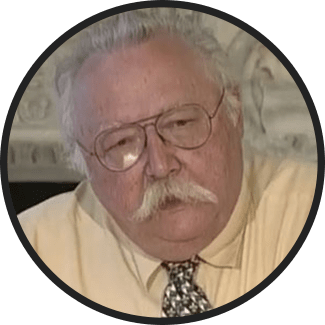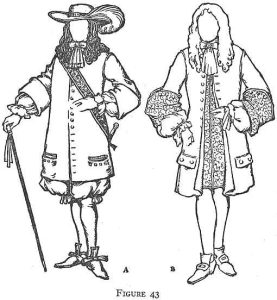Contents
Contents
John Murray, fourth Earl of Dunmore, the last royal governor of Virginia, in April 1772 expressed his conviction to Lord Dartmouth, British secretary of state for the colonies, that “in case of a War” the slaves, “attached by no tye to their Master or to the Country” would “join the first that would encourage them to revenge themselves by which means a Conquest of this Country would inevitably be effected in a very short time.” Dunmore’s fears were shared by many white Virginians, though none expected that three years later Dunmore himself would attempt “a Conquest of this Country” with the help of African-American slaves.
The early 1770s were a period of slave unrest in Virginia, prompting the city of Williamsburg to establish a night watch in July 1772 to apprehend “disorderly People, Slaves as well as others.” Slave restiveness increased when news of the Somersett case reached the colonies in September 1772. James Somersett, a slave taken to England by his master Charles Steuart, had run away. Recaptured and in chains in the hull of a ship bound for Jamaica, he sued for his freedom. In June 1772, Lord Mansfield, Chief Justice of the King’s Bench, held that slavery “is so odious, that nothing can be suffered to support it, but positive law.” As “the law of England” neither “allowed” nor “approved” of slavery, Mansfield ruled that “the black must be discharged.”
Mansfield’s decision outlawed slavery only in England; it did not apply to British colonies. But that was immaterial to American slaves. In January 1773, the General Court in Boston received the first of three petitions in which slaves pleaded their freedom with the argument that Mansfield’s decision should indeed apply to the colonies, where they were “held in a state of Slavery within a free and Christian Country.”
By September 1773, the first of Virginia’s 250,000 slaves were also trying to get “out of the Colony, particularly to Britain” – so noted John Austin Finnie’s advertisement for runaways Bacchus and Amy – “where they imagine they will be free.” The king was on their side – or so slaves thought – and against their masters, who feared a British-instigated slave revolt. Following the discovery in November 1774 of slaves conspiring to desert “when the English troops should arrive,” James Madison wrote to William Bradford of his conviction that “If america & Britain come to an hostile rupture I am afraid an Insurrection among the slaves may & will be promoted” in an attempt to preserve Virginia for the crown of King George III.
When tensions between Dunmore and Virginia’s ruling elite increased in early 1775, the ground was well prepared for his lordship to “arm all my own Negroes and receive all others that will come to me who I shall declare free,” as he wrote to Dartmouth on March 1. Dunmore could argue that since the colonists were clamoring for English law, they could get a taste of it, Somersett and all. The slaves, on the other hand, considered the government in London and its local representatives to be sympathetic to their cause, and they were only waiting for the sign to take up arms to “reduce the refractory people of this Colony to obedience.”
Armed conflict was looming, and Dunmore ordered Royal Marines to seize the gunpowder stored in the Williamsburg Magazine during the night of April 20-21. When Virginia threatened to erupt in open violence, Dunmore backed down. Forced to pay restitution for the powder, Dunmore lost his temper in front of the town leaders. Williamsburg resident Dr. William Pasteur heard the governor say that he would “declare freedom to the slaves and reduce the City of Williamsburg to ashes.” He boasted he would have “all the slaves on the side of the government”. By mid-May, rumors of Dunmore’s plans had spread all the way to Boston, from where General Thomas Gage, Governor of Massachusetts, informed Dartmouth: “We hear that a Declaration his Lordship has made, of proclaiming all the Negroes free, who should join him, has Startled the Insurgents.
Gage was jumping the gun but not by much. On June 8, Dunmore fled Williamsburg for the safety of the man-of-war Fowey at Yorktown. The Virginia Convention quickly assured the governor of his own personal safety but expressed its extreme displeasure of this “most diabolical” scheme “meditated, and generally recommended, by a Person of great Influence, to offer Freedom to our slaves, and turn them against their Masters.” But Dunmore felt that he had no alternative. His ranks reduced to some 300 soldiers, sailors, and loyalists, he let it be known that he welcomed supporters of any skin color. As word spread along the coast, about 100 black runaways reached Dunmore’s fleet during the fall of 1775. In early November his troops routed a corps of Virginia militia at Kemp’s Landing. That was the signal for the publication of Dunmore’s long-anticipated proclamation to American slaves.
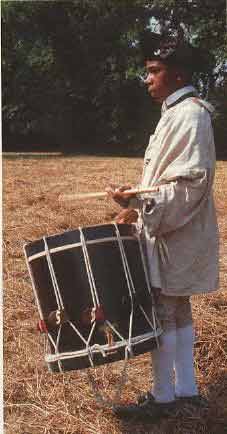
The response was overwhelming. By December 1, about 300 runaways were carrying muskets and wearing the garb of Lord Dunmore’s Ethiopian Regiment, the words “Liberty to Slaves” emblazoned on their chests. During the Battle of Great Bridge on December 9, they accounted for about half of Dunmore’s 600 men. After losing 17 killed and 49 wounded, he retreated to his fleet.
The Virginia Convention decreed death to “all Negro or other Slaves, conspiring to rebel or make insurrection.” Those who laid down their arms and returned within ten days would be pardoned; all others would be sold in the West Indies. To set an example, 32 black runaways taken at Great Bridge were ordered sold in the Caribbean in January 1776.
Despite a fever epidemic and reports of “Hungry bellies, naked backs, and no fuel… the most cruel and inhuman treatment,” runaways were lured to the coast. On March 30, 1776, Dunmore informed Lord Germain: “I have been endeavoring to raise two regiments here – one of white people, the other of black. The former goes on very slowly, but the latter very well.”
By the summer of 1776, at least 800 blacks “willing to bear arms” had joined Dunmore’s force now quartered on Gwynn’s Island. When he left Virginia for good on August 7, only about 300 were still alive; all others had died of fevers. Once Dunmore had cast anchor in New York seven days later, the regiment was dissolved, and the former soldiers left to fend for themselves.
Dunmore’s proclamation had been driven as much by political as by military considerations, but his early attempt at using blacks as soldiers never became general policy. Sir William Howe, who had replaced Gage in September 1775, was personally opposed to their use and dismissed blacks wherever he could find them. Provincial forces wore ordered to “be put on the most Respectable Footing [and] all Negroes, Molattoes and other Improper Persons who have been admitted into these Corps be immediately discharged.” King George’s army would remain a white army.
It is hard to estimate how many free blacks and slaves served in the Royal Army, but whatever the number; it is only a fraction of those who were willing to wear red coats-if only the British had let them. It is not that the blacks were necessarily pro-British; first and foremost they were pro-black, prepared to support the side that held out the greatest hope for them to improve their lot. That side was the British, as their response to Dunmore’s proclamation showed. But freedom, the price for black help in the war, was a price neither the British nor their loyalist allies were prepared to pay.
As black soldiers were becoming a rarity in the British army, their numbers were increasing on the American side. When Congress instructed the states in September 1776 to raise 88 infantry battalions, few African-Americans were left in the Continental Army. Southern opposition had resulted in the exclusion of most black men. However, the realities of war forced Congress and the states to reevaluate their policies.
Despite bonuses and bounties, recruits were slow to sign up. To bring the Continental Army up to strength, Congress ordered the states in January 1777 to fill their units “by drafts, from their militia, or in any other way.” As Virginia was unable to meet her quota of 10,200 men with volunteers, a draft based on the existing militia lists had to be considered. The Militia Act of the summer of 1775 had required that “all free male persons, hired servants, and apprentices between the ages of 16 and 50 years . . . be enrolled or forced into companies.” This excluded slaves by definition, but free blacks were registered to serve, though “without arms.”
Registration on a militia list was one thing, serving in the Continental Army was quite another. The militia usually served short-term and hardly ever outside state boundaries. The Continental Army wanted long-term soldiers who served wherever needed, an unappealing prospect for Virginians at a time of heightened slave unrest and the threat of wholesale desertion of their black property to the British.
The lottery-based draft law enacted in May 1777 greatly increased the number of blacks in the Virginia Line. Free blacks were the first to be called up, as Virginia tightened the enforcement of the draft. “It was thought that they could best be spared,” Governor Thomas Nelson informed George Washington.
Very few free blacks were as wealthy as James Harris of Charles City County, who was able to afford a substitute to fight in his place in 1780; most had no choice but to join up. But slave owners could afford substitutes and, when faced with a draft notice, many a master presented a slave to the recruiting officer for a freeman and a substitute. Many a runaway told the nearest recruiter that he was a freeman, anxious to fight.
More often than not, he was accepted without too many questions; the army was always short of men. General Washington himself had opened the door for African-Americans in his general orders of January 12, 1777, in which he instructed recruiters to “enlist none but Freemen,” the implication being that the recruit could be black just as long as he was free. To put an end to such unpatriotic behavior on the part of some masters and to stop the self-emancipation of slaves, the Virginia Legislature amended the 1775 Militia Law in June 1777 by “forbidding any recruiting officers within this Commonwealth to enlist any negro or 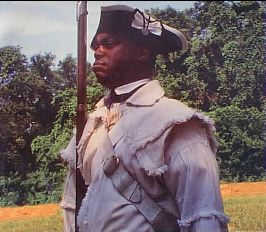
During the winter of 1777-78, dozens of black Virginians served in every one of the state regiments, freezing, starving, and dying at Valley Forge. By February 1778, the survivors were marching with white comrades through the snow, practicing Baron von Steuben’s as yet unfamiliar drill. When the Steuben-trained army proved its mettle at Monmouth in June, about 700 blacks fought side-by-side with whites. Eight weeks later, an army report listed 755 blacks in the Continental Army, including 138 Blacks in the Virginia Line.
Partially in response to Monmouth, Sir Henry Clinton, who had replaced Howe in May 1778, shifted the theater of war to the South. On June 30, 1779, Clinton promised in his Philippsburg Declaration that “every NEGRO who shall desert the Rebel Standard, [is granted] full security to follow within these Lines, any Occupation which he shall think proper.” In response, tens of thousands of slaves fled behind British lines.
In May 1780 Charleston fell, and most of the Virginia Line were taken prisoners. When General Horatio Gates lost at Camden in August, Virginia lay virtually defenseless before Lord Cornwallis. The military situation was serious enough that a debate concerning the arming of slaves began in the new capital of Richmond. There was ample precedence for such a step.
New Jersey’s Militia Act of May 1777 permitted masters to enlist slaves as substitutes. New Hampshire opened the door to the recruitment of slaves to fill the state’s Continental quota in the fall of that year, and Connecticut soon followed suit. In October 1780 an all black unit, the 2nd Company, 4th Connecticut Regiment, was formed. That company, some 48 black privates and NCOs under four white officers, existed until November 1782.
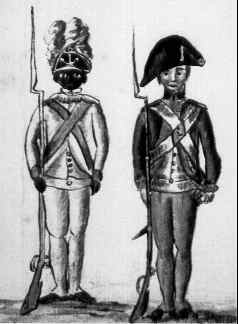
Although the white sails of Major General Alexander Leslie’s fleet with 2,500 British troops on board had already appeared in Hampton Roads, the Virginia Legislature refused to arm slaves. Instead, it voted in October 1780 to grant every recruit who enlisted for the duration of the war 300 acres of land and the choice between a healthy black male slave between the ages of 10 and 30 years or £60 in specie. The slave bonus would be raised by a special tax on planters who owned more than 20 slaves. The use of slaves as bounties later became known as “Sumter’s Law,” after General Thomas Sumter, who began offering Tory slaves as enlistment bonuses in South Carolina in April 1781.
Military necessity made the Continental Army and the Virginia State Line an integrated force. Observed a Hessian officer: “The Negro can take the field instead of his master, and therefore no regiment is to be seen in which there are not Negroes in abundance, and among them are able-bodied and strong fellows.” What the diarist did not report was that every Hessian regiment contained black soldiers as well.
Britain’s German auxiliaries had disembarked in New York during the early summer of 1776; by March 1777 they had begun to recruit black volunteers. Facing manpower shortages as severe as those of the British, they quickly tapped the labor pool of runaways. Hundreds served as laborers or servants, but the Germans readily put blacks in uniform as well.
Most of the 115 African-Americans on Hessen-Cassel and Hessen-Hanau regimental rosters came from southern states. Many were very young, mere children of 11, 12, 13 years, who served as drummers and fifers, freeing up older, taller whites for service with the musket. Hessian records from 1777 to 1783 show 83 black drummers as well as 3 fifers.
On the eve of departure for Europe, the Hessians discharged some two dozen black men who wanted to stay in America. About 30 soldiers plus an unknown number of officer servants not on regimental rosters, some with their wives and children, crossed the Atlantic for Cassel, where they arrived in late 1783.
A contingent of Brunswick troops under Baron Friedrich Adolf von Riedesel that had been captured at Saratoga spent four years as part of the Convention Army interned around Charlottesville. In February 1781 the exchanged Baron Riedesel encouraged his officers to recruit black soldiers from among the refugees in New York. Among them was James Barkes of Williamsburg, possibly a former slave of Norfolk merchant James Parker and a survivor of Dunmore’s regiment.
In France, Africans had served in the armed forces since the late 17th century. When the Comte de Rochambeau’s expeditionary corps stepped ashore in Newport in 1780, it counted at least one black soldier in its ranks: Jean-Baptiste Pandoua from Madagascar, who had joined the Bourbonnais regiment as a musician in 1777. He deserted in June 1782, while his regiment was quartered in Virginia. Unlike other participants in the war; the French did not, could not, recruit American blacks. After all, they had come to aid the Americans, not to steal their property.
In June 1781, the French and American armies joined forces at White Plains. Baron Closen, a German officer in the French Royal Deux-Ponts, estimated the American army to be about one-fourth black, about 1,200 –1,500 men out of less than 6,000 Continentals! On the eve of its decisive victory over Lord Cornwallis, the Continental Army had reached a degree of integration it would not achieve again for another 200 years. Among the troops at White Plains was the Rhode Island Regiment (the two bataillons had been consolidated on 1 January 1781) with its high percentage of African-Americans, which Closen considered the best American unit: “the most neatly dressed, the best under arms, and the most precise in its maneuvres.
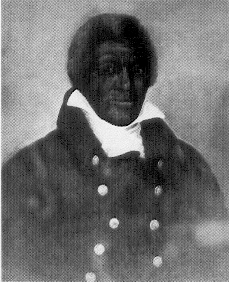
Lafayette’s attempts at infiltrating British headquarters were futile until the first week of July, when Cornwallis hired James Armistead to spy on the Americans. Though Lafayette had to inform Washington on July 31 that “His lordship is So Shy of His papers that My Honest friend Says He Cannot get at them,” the written and oral reports of the unlikely double agent kept the allies apprised of British plans. On August 25, Lafayette could report that Cornwallis had begun “fortifing at York.” On September 28, the siege began.
The First Rhode Island Regiment, the only all-black American unit at the siege, formed part of Major General Benjamin Lincoln’s division. The soldiers were among the 4,300 men who dug the first parallel on the evening of October 6 about 550 yards from the enemy. They were in the trenches on the 9th, when the first American artillery shells hit Yorktown. And they were in the trenches again on the night of the 15th, when Lord Cornwallis made his only serious sortie against the Franco-American siege lines.
Two days later, surrender negotiations began; in the early afternoon of the 19th, the defeated British army and German allies laid down their arms. Yorktown lay in ruins. Death and destruction were everywhere. All over the place and wherever you looked,” Private Georg Daniel Flohr of the Royal Deux-Ponts saw “corpses… lying about that had not been buried; the larger part of these were Mohren.” They were the corpses of black Hessians and black Frenchmen, black Englishmen and black Americans. They all had fought each other at Yorktown.
Among the survivors, a few black Hessians made it to Germany, and a smaller number was spirited away by the French. Black patriots numbering some 5,000, including about 500 black Virginians, soon went home, too.
In 1782, Virginia had passed a law permitting manumission with the stipulation that former owners remain responsible for manumitted slaves unable to support themselves. Between 1782 and 1792, about 1,000 slaves, undoubtedly including some who had fought for their masters, were manumitted by them. But more were returned to slavery, so that even a legislature such as Virginia’s, dominated as it was by slave owners, spoke out against the obvious injustice.
In the fall of 1783, the Assembly passed a bill condemning owners who “contrary to principles of justice and to their own solemn promise” kept their soldier substitutes as slaves. They were freed by legislative decree with instructions to the attorney general of Virginia to act on behalf of any former slave held in servitude despite his enlistment. how many slaves received their freedom as a result of this bill is not known, since a slave could not himself initiate legal proceedings for his own manumission.
But if the number of slaves freed by the legislature as a reward for nonmilitary service is any indication, they were few. Eight slaves are known to have been granted freedom by the legislature for service in the Revolutionary War.
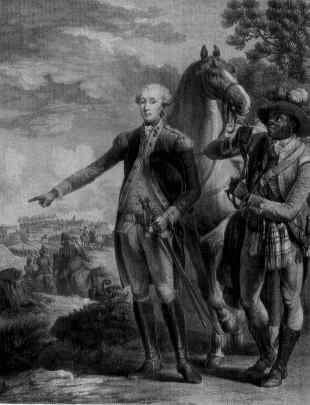
In October 1784, Lafayette (in the picture on the left with Armistead holding his horse) penned a certificate declaring that James Armistead had done “Essential Service” in collecting “Intelligence from the Ennemy’s Camp” and was therefore “Entitled to Every Reward His Situation Can Admit of.” The document in hand, Armistead hurried to the legislature, where his manumission request came up in December. But more than two years would pass until his emancipation on January 9, 1787.
“At the peril of his life” he had “found means to frequent the British camp” and collect information essential to the American cause. Now he was free, while his master was compensated at the going auction-block figure.
In 1816, he bought 40 acres of land in New Kent County, where he raised his family. In 1819, Virginia granted him $60 relief money and put him on the regular pension roll at $40 a year. In 1824, the marquis and James Lafayette – as he now called himself – met one last time in Richmond, during Lafayette’s triumphant tour of the United States.
Virginia’s Black Codes
Colonial militias were typically composed of most adult men capable of bearing arms in a community. Unlike a standing army, militias served primarily as a manpower pool from which soldiers were drawn as needed in emergencies and for expeditions against Indians. Originally militias were very inclusive, but as the 17th century neared its end, they became more selective. Indentured servants, free blacks, and slaves were the first to he purged.
Virginia led the way among the colonies in excluding blacks from militia service, when the House of Burgesses required in January 1639 that only white Virginians arm themselves. Yet, in a pattern that was to repeat itself into the 18th century, both sides armed slaves and promised them freedom in exchange for military service in 1676 during Bacon’s Rebellion.
The year 1705 brought the first true slave code to Virginia. Under this code, slaves were – and remained – excluded from military service. Skin color rather than legal status determined the role of free blacks as well. In many ways they, too, were subject to the slave code.
The code of 1705 denied the few free blacks living in the colony the right to serve in the militia on an equal footing with whites. The code of 1723, confirmed in 1748, assigned free blacks only a role as drummers or trumpeters. But in emergencies such as invasion, insurrection, or rebellion, they could “march with the militia and . . . do the duty of pioneers or such other servile labor as they shall be directed to perform.”
After 1723, “no negro, mulatto, or Indian whatsoever” was allowed to carry a firearm under penalty of up to 39 lashes. Only a black slave who lived on the frontier and who had a license from the justice of the peace, or if he was a free man and “enlisted in the militia… may be permitted to keep one gun, powder and shot.”
This was the law in 1754, when Virginia prepared for yet another war with France and her Indian allies. In a move that did not endear him to white Virginians, General Edward Braddock seized upon this provision and in mid-March 1755 wrote Robert Napier from Williamsburg: “There are here a number of mulattoes and free Negroes of whom I shall make bat men, whom the province are to furnish with pay and frocks.” In July, Braddock’s expedition ended in disaster at the Monongahela River, despite last-minute orders that batmen carry firearms and ready themselves for combat.
To ward off the expected Franco-Indian invasion, Virginia Governor Robert Dinwiddie pressured the House of Burgesses for a new militia law. But the assembly only authorized the enlistment of free blacks as drummers, trumpeters, or pioneers. The following year, 1756, the legislature increased the authorized strength of Colonel George Washington’s Virginia Regiment to 1,500 men. But when white recruits did not join up in sufficient numbers, free blacks took their places. Yet the Militia Law of 1757 still denied free blacks the right to carry arms. On the frontier, however, military necessity voided legislative intent. Some 36 black soldiers formed part of Washington’s force ready to attack Fort Duquesne in October 1758.
What kept crown officials and Virginia planters from using the black manpower potential of the colony was fear. They were afraid that in an insurrection, free and freed blacks might make common cause with their own slaves. In July 1755, Governor Robert Dinwiddie wrote to Charles Carter that “the villany of the Negroes on an emergency of govt is w’t I always fear.”
Twenty years later, in early 1775, frightened Virginians sold back into slavery a freed black named Sam, “when it was discovered he was attempting to inveigle away a number of negroes to the new or Indian country.” Sam had purchased his freedom in 1772 and served with Lord Dunmore against the Indians in the late summer and fall of 1774.
When Sam ran away from his new master in May 1775, a new militia law was being debated in Richmond, which sounded inclusive enough when it assigned the right to serve in the militia to “all free male persons, hired servants, and apprentices between the ages of 16 and 50 years.” Blacks, even if free and male, had to register for militia duty but could only serve “without arms.” Lord Dunmore’s proclamation of November 1775 and the manpower needs of the war on the American side soon rendered that restriction obsolete.
Recommended further reading
Books
Aptheker, Herbert. “A Documentary History of the Negro People in the United States.” New York, 1962.
Buckley, Robert N., “Slaves in Red Coats: The British West India Regiments, 1795-1815”. New Haven: Yale U, 1979.
Crow, Jeffrey J. “The Black Experience in Revolutionary North Carolina.” North Carolina Division of Archives and History, 1996.
Davis, Burke, “Black Heroes of the American Revolution.” New York: Harcourt, Brace, Jovanovich, 1976. Paperback, 82 pages.
Written for high school students, this readable work provides an easily comprehensible summary of some famous black soldiers, army messengers, and other black patriots.
Davis, Lenwood G. and George Hill. “Blacks in the American Armed Forces, 1776-1983: A Bibliography.” Forewords by Benjamin O. Davis, Jr. and Percy E. Johnston. Greenwood Press, Westport, Connecticut. 1985.
Eicholz, Alice and James M. Rose, comps. Free Black Heads of Household in the New York State Federal Census, 1790-1830. Gale Genealogy and Local History Series, vol. 14. Detroit, MI: Gale Research Co., 1981.
Foner, Philip S. “Blacks in the American Revolution.” Greenwood Press, Westport, Connecticut. 1975.
Though there is little new presented here, either in information or interpretations, this book could be helpful in classrooms. There is background material about pre-war abolition movements, the role of black regiments on both sides of the fighting, and the post-war termination of the slave trade in the north. Three useful appendices are attached to what are basically one hundred pages of text that appeared in Foner’s previous work on colonial blacks.
Frey, Sylvia R. “Water From the Rock: Black Resistance in a Revolutionary Age.” Princeton, NJ, 1991.
Garrison, William L., et al. “The Negro Soldier: A Select Compilation”. NY: Negro U, 1970; orig pub 1861. Guide to articles on blacks in American wars, 1641-1815.
Glasrud, Bruce A. and Smith, Alan M. (Eds) “Race Relations in British North America, 1607-1783.” Chicago, 1982.
Greene, Robert Ewell. “Black Courage, 1775-1783.” NSDAR. 1984.
Guthrie, James M. “Camp-Fires of the Afro-American”, Phila: Afro-American, 1899. See Chaps 3-13.
Johnson, Jesse J. (Editor). “A Pictorial History of Black Soldiers (1619-1969) in Peace and War.” Hampton Institute, Hampton, Virginia. 1969.
Kaplan, Sidney and Emma Nogrady Kaplan. “The Black Presence in the Era of the American Revolution, 1770-1800.” New York, 1973.
Though without footnotes or a bibliography, this handsomely illustrated volume may be useful for undergraduates. Kaplan notes that blacks were involved in virtually every major campaign, and that some were Loyalists. The visual material is excellent.
MacLeod Duncan J. “Slavery, Race and the American Revolution.” New York, 1974.
McConnell, Richard C. “Negro Troops of Antebellum Louisiana, A History of the Battalion of Men of Free Color.” Baton Rouge: Louisiana State University Press, 1968.
Pages fifteen to twenty-two contain data about black militia who fought under the Spanish led by Galvez at Mobile and Pensacola.
Moore, Frank. Diary of the American Revolution From Newspapers and Original Documents. 2 vols. NY: Scribner, 1860. See index “Negroes.”
Moss, Bobby. “The Patriots at the Cowpens.” A roster of the patriots who fought at the Battle of Cowpens. Paperback, 338 pages. Contains entries for several individual free blacks.
Mullen, Robert F. “Blacks in America’s Wars: The Shift in Attitudes from the Revolutionary War to Vietnam.” Monad Press. 1974.
Nalty, Bernard C. Strength for the Fight: a History of Black Americans in the Military. New York: Free Press, 1986.
Nell, William Cooper. The Colored Patriots of the American Revolution, with Sketches of Several Distinguished Colored Persons, to Which Is Added a Brief Survey of the Condition and Prospects of Colored Americans. Boston: R.F. Wallcut, 1855. Reprint. New York: Arno Press, 1968.
This is one of the first scholarly works to document the contributions of blacks towards the patriotic cause. Harriet Beecher Stowe and Wendell Phillips, the famed abolitionists, wrote introductions to this book.
Opinions of the Early Presidents and of the Fathers of the Republic upon Slavery and upon Negroes as Men and Soldiers. Pamphlets, Loyal Publication Society, vol. 18. New York: C. Bryant & Co., Printers, 1863.
Quarles, Benjamin. “The Negro in the American Revolution.” Univ. of North Carolina,1961.
This fine study is the first comprehensive treatment of this topic. Although it is now outdated by current scholarship, it clearly indicates how important the participation of blacks was for both sides in the war. The book is particularly useful in explaining why some states were unable to fill their regimental quotas with black slaves or freedmen. The material about the colonial status of blacks is excellent.
Quarles, Benjamin and Fishell, Leslie H. Jr. “The Black American.” Glenview, Ill., 1970.
Quarles, Benjamin. “The Negro in the Making of America.” Collier Books, New York. 1964.
Smith, James Avery “The History of the Black Population of Amherst, MA, 1728-1870”, New England Historic Genealogical Society, 160 North Washington St., Boston, MA 02114-2120
Sterling, Dorothy, ed. Speak Out in Thunder Tones: Letters and Other Writings by Black Northerners, 1787-1865. Garden City, NY: Doubleday, 1973.
White, David O. Connecticut’s Black Soldiers, 1775-1783. Chester, CT: Pequot, 1973.
This is a pedestrian account about the status of slavery in Connecticut. But the tabulation of some 290 black soldiers from the state is useful, for the author has determined the towns the blacks served, their service, and if they were pensioned.
Wilkes, Laura E. Missing “Pages in American History, Revealing the Services of Negroes in the early Wars of the United States of America, 1641-1815.” (In “The Negro Soldier: A Select Compilation.” Reprint. Negro University Press, New York. Originally Published1861, Robert F. Walcutt, Boston.) 1970.
Williams, George W. “History of the Negro Race in American From 1619 to 1880”, 2 vols., See Vol 1, Chaps 26-31, NY,Putnams, 1883.
Wilson, Joseph T. “The Black Phalanx, A History of the Negro Soldiers of the United States in the wars of 1775-1812, 1861-1865.” Reprint. Arno Press, New York. (Originally Published1885, Robert F. Walcutt, Boston.) 1968.
Woodson, Carter G. “The Negro in Our History.” Washington DC, 1962.
U.S. Army Military History Research Collection. The U.S. Army and the Negro. Carlisle Barracks, Pa: U.S. Army Military History Research Collection, 1971.
Articles and essays
Adrien, Claude. “The Forgotten Heroes of Savannah.” Americas, 30 (11-12) (1978), 55-57.
This article covers the epic of the Haitian Black Legion which aided the Americans and the French at their aborted siege of Savannah in 1779.
Barnett, Paul. “The Black Continentals.” Negro Hist Bull, 33 (1970), 6-10.
Here is a readable treatment of a black regiment serving under Colonel Christopher Greene.
Boatner, Mark M., III. “The Negro in the Revolution.” Amer Hist Illus, 4 (2) (1969), 36-44.
Some 5,000 blacks served on the American side, and an unknown number for the British. Many slaves wanted to join the patriot cause, but most colonists feared a slave insurrection.
Bowman, Larry G. “Virginia’s Use of Blacks in the French and Indian War.” Western Pennsylvania Historical Magazine 53:57-63. 1970.
Brown, Wallace. “Negroes and the American Revolution.” Hist Today, 14 (1964), 556-563.
Brown provides a convenient analysis of blacks used by the Americans and the British in the armed forces and as laborers during the war.
Bull, Lisa A. “The Negro.” Hist J of West Mass, Supplement, (1976), 67-74.
The author explains that the prime motivation of blacks who served in integrated and segregated military units was to gain freedom.
Conlon, Noel P. “Rhode Island Negroes in the Revolution: A Bibliography.” RI Hist, 29 (1970), 52-53.
Here are some forty citations about Rhode Island blacks during the war.
Cresto, Kathleen M. “The Negro: Symbol and Participant of the American Revolution.” Negro Hist Bull, 39 (1976), 628-631.
This summary is useful for high-schoolers.
Farley, M. Foster. “The South Carolina Negro in the American Revolution, 1775-1783.” SC Hist Mag, 79 (1978), pp. 75-80.
Carolina slaves were used by both sides as soldiers, sailors, and laborers.
Gough, Robert J. “Black Men and the Early New Jersey Militia.” NJ HIST, 88 (1970), 227-338.
Excluding blacks from the pre-war colonial militia, New Jersey permitted freed blacks to serve in mixed regiments in 1777; but the status of black soldiers remained uncertain until 1792.
Greene, Lorenzo J. “The Negro in the Armed Forces of the United States, 1619- 1783.” Negro History Bulletin 14:123-127. 1951.
Greene, Lorenzo J. “Some Observations on the Black Regiment of Rhode Island in the American Revolution.” Journal of Negro History 37 (1952), 142-172.
In a valuable essay, Greene tabulates the names of 168 men raised for a Rhode Island regiment in February, 1778. Slaves were permitted to join and their masters were compensated.
Hargrove, W.B. “The Negro Soldier in the American Revolution.” Journal of Negro History 1:110-137. 1916.
Hargrove examines the debate in Congress about permitting freedmen to enlist in eighteen regiments, and how the states handled the matter.
Jackson, Luther P. “Virginia Negro Soldiers and Seamen in the American Revolution.” Journal of Negro History 27:247-287. 1942.
In a sweeping summary, Jackson focuses on the debate about using freedmen or slaves as soldiers. Masters used slaves as substitutes for their own service; perhaps 500 Virginia blacks were in uniform during the war.
Jones, George Fenwick. “The Black Hessians: Negroes Recruited by the Hessians in South Carolina and Other Colonies.” SC Hist Mag 83 (Oct 1982): pp. 287-302.
Maslowski, Pete National Policy Toward the Use of Black Troops in the Revolution. South Carolina Historical Magazine 73:1-17. 1972.
Despite the efforts of Henry and John Laurens to draft blacks into the services, the South Carolina and Georgia legislators opposed this approach. Yet Benjamin Lincoln and Nathanael Greene had black troops in their commands.
McElroy, Guy C. “Facing History: the Black Image in American Art, 1710-1940”. Essay by Henry Louis Gates, Jr. Contributions by Janet Levine, Francis Martin, Jr., and Claudia Vess. Edited by Christopher C. Washington, DC: Corcoran Gallery of Art, 1990.
Moore, George H. “Historical Notes on the Employment of Negroes in the American Army of the Revolution.” MAG OF HIST, 1 (1907)
This is an early attempt to analyze the number of blacks used as regulars, militia, and as laborers for the Continentals.
Norton, Mary Beth, “The Fate of Some Black Loyalists of the American Revolution.” Journal of Negro History, Vol. LVIII, pp. 402-426. 1973.
Porter, Dorothy B. “The Black Role During the Revolution.” SMITHSONIAN, 4 (1973), 52-57.
This essay feebly summarizes the role of prominent American black males in the 1700-1800 era.
Quarles, Benjamin. “Crispus Attucks.” Amer Hist Illus, 5 (4) (1970), pp. 38-42.
Here is a convenient summary about a black hero of the Revolution killed in the Boston Massacre.
Quarles, Benjamin. “The Colonial Militia and Negro Manpower.” MS Valley Hist Rev 45 (Mar 1959): pp. 643-652.
Reddick, L.D. The Negro Policy of the United States Army, 1775-1945. Journal of Negro History 34:9-29. 1949.
Rider, Sidney S. “Historical Inquiry Concerning the Attempt to Raise a Regiment of Slaves By Rhode Island During the War of the American Revolution.” RI Hist Tracts, 10 (1880), pp, 1-86.
Rider wrote a good account of slaves who enlisted in Continental regiments, with comments about their owners and their market value.
Walker, James St.G. “Blacks as American Loyalists: The Slave War for Independence.” Hist Reflections, 2 (1975), pp.51-67.
Under Dunmore and Clinton, the British recruited black troops who were not pro-British but were “pro-black,” hoping that military service would lead to freedom. This is a very thoughtful article and perhaps the best on the subject.
Additionally, The Journal of Negro History from the 1910’s through the 1970’s has a number of articles on the subject from all over the colonies.
Related theses and reports
Ansel, Colonel Raymond. “From Segregation to Desegregation: Blacks In the U.S. Army 1703-1954.” Thesis, U.S. Army War College, Carlisle Barracks, Pennsylvania. 1990.
Aptheker, Herbert. The Negro in the American Revolution. NY: International, 1940. 47 p.
Moore, George H. Historical Notes on the Employment of Negroes in the American Army of the Revolution. NY: Evans, 1862. 24 p.
U.S. Army War College. Hist Sec. The Attempts of Rhode Island to Raise a Regiment of Slaves for Service in the War of the Revolution – The So-Called “Rhode Island Black Regiment” of 1778. Report, 10 p. File #127-23F/W, Arch. Incl 2 clippings.

